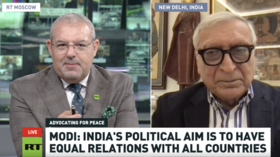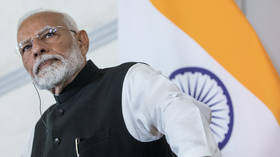Modi in Ukraine: How India demonstrates that the next era of global diplomacy will not be lead by the West
While no major Western leader made a concrete effort to engage with both Kiev and Moscow, Indian PM has showcased true willingness to find a long-term, mutually acceptable resolution to the conflict
As Prime Minister of India Narendra Modi embarked on a rail trip to the embattled Ukrainian capital Kiev, the visit looked ironically similar to the intense shuttle diplomacy conducted by the United States after the 1972 Arab-Israel War. Heightening its significance was the fact that it was the first visit of an Indian premier since Ukraine gained independence in 1991.
Barely seven weeks earlier, Modi had embarked on a trip to India’s longtime ally Russia, the first official foreign visit of his government’s third term. While India’s Western allies were direct but restrained in their criticism, Ukraine’s Vladimir Zelensky issued a much harsher rebuke, declaring that it was a “huge disappointment… to see the leader of the world’s largest democracy hug the world’s most bloody criminal in Moscow on such a day,” as that same day a prominent children’s hospital in Ukraine had been struck, with many casualties.
Some commenters suggest that Modi’s visit was orchestrated to alleviate Ukraine’s anger towards his previous visit to Moscow.
However, a seasoned expert in Indian foreign policy would patiently point out how it follows its own path, dictated by its own national interests and how it plays out in a strategically balanced approach towards world politics. New Delhi knows its place on the international stage and its stature vis-a-vis the rest of the world, and proceeds accordingly.
The current visit underscores the difficulties in maintaining a sensitive, balancing status quo in an increasingly divergent and fracturing world. Just days before Modi embarked on his trip to Poland and Ukraine, the Russian Navy chief, Admiral Alekseyevich Moiseyev, arrived in India for an official four-day visit, reflective of the changing geopolitical map of South Asia following events in Bangladesh.
A new peace plan?
Peace efforts are successful when, instead of being one-sided and declarative, the processes and platforms are accommodating towards the belligerent parties. Instead, we witnessed the Summit on Peace in Ukraine held in Switzerland earlier this year, where a major party to the conflict wasn’t invited.
India, nevertheless, attended the event to signify its resolve for peace and diplomacy but refrained from signing the Joint Communique due to Russia’s absence. Therefore, coupled with the global push towards multilateralism and multipolarity, it is increasingly the major non-Western powers that are now playing an increasingly vital role in mediating conflicts.
The now-botched peace process between Russia and Ukraine in the spring of 2022 almost came to fruition due to intensive mediation by Israel and Turkey, neither of them traditional Western powers. Ironically, according to veteran investigative journalist Seymour Hersh and former Israeli PM Naftali Bennett, it was the US-led West that pulled the plug on those peace talks.
Western states can’t explicitly support one belligerent over the other and then propose themselves to be neutral arbiters in any upcoming peace process. With the apparent limits of Western influence starkly exposed with their failed sanctions regime, and a rising China in the Indo-Pacific, the onus for maintaining and pursuing global peace and stability naturally falls on non-Western states – leaders of the Global South who can be considered as impartial and neutral mediators in times of conflict.
As of now, no major Western leader has made a concrete effort to visit Russia, even to promote peace talks. Such an act is paramount to bridge divides that can’t be resolved through conflict. Reiterating that “India firmly believes that no problem can be solved on the battlefield,” Modi has roundly placed his country “on the side of peace.”
Winds of change
The prime minister’s visit to Poland marks the first time in 45 years that an Indian head of state visited that country. This heralds a subtle but nevertheless significant shift in Indian policy towards central and eastern Europe, which New Delhi had been reluctant to actively engage, given its closeness to the newly created Russian Federation. Therefore, even after the USSR’s breakup, ties between the former members of the Warsaw Pact proceeded more gradually than relations with, for instance, the US or Western Europe.
However, Western backing and the changing geopolitical dynamics catapulted the conflict in Europe into a global agenda, thus overshadowing many of the pressing issues of the developing world. India, as the self-proclaimed leader of the Global South, is now seeking greater engagements with the rest of the conflict’s stakeholders, in an attempt to urge them towards peace and diplomacy.
The efforts seem to be working. Zelensky proposed that the next peace-process function be held in India, which had recently succeeded beyond expectations during the G20 leader’s summit by bringing the bloc participants together to sign a Declaration acceptable to all. Zelensky, however, noted that it would be “logical” if India first signs the communique of the Switzerland summit, if it is to host the next peace summit. But given India’s well-known stance, it seems unlikely New Delhi will sign the communique unless Russian presence is guaranteed in the peace process.
Combined with the greater visibility of BRICS+ as a prominent platform of non-Western narratives, the upending of the liberal-international order and the ushering in of a multipolar one, the non-Western world is a reality to reckon with. Modi has proven to the powers-that-be that it is possible to set aside differences if there is a true willingness towards establishing a long-term, mutually acceptable, peaceful settlement for all.
The statements, views and opinions expressed in this column are solely those of the author and do not necessarily represent those of RT.







Comments are closed.